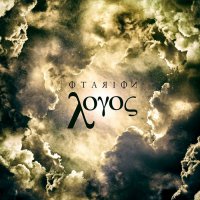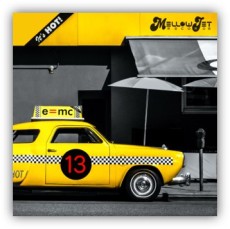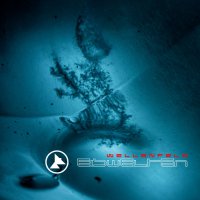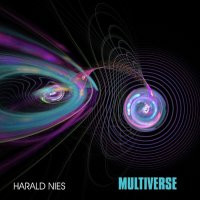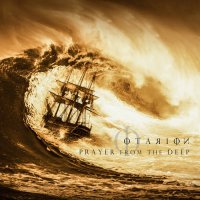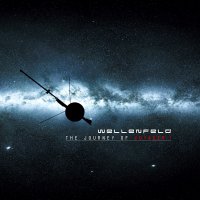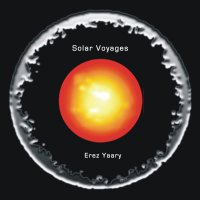Otarion - Logos
04/27/2023
Sylvain

I may as well say it from the start; the crusades, the massacres and the sexual scandals that have always been part of the history of the Christian religion have made me an atheist. Paradoxically, I like to listen to those feature films extolling the stories of Moses and Jesus Christ that swarm our television screens during the Easter era. And I thought, well, maybe it's time to talk about this new opus from Otarion entitled LOGOS. Initially, I thought it was a nod to the music of Tangerine Dream. And yet, from the first listen I felt that Rainer Klein's new offering had more of a pastoral feel to it than fragrances of the electronic music (EM) of Franke, Froese and Schmoelling's metal years. There is a rather biblical cinematic intensity that hovers over the 12 structures, with the exception of Pentecost, of this new album that MellowJet Records has just released in CD-(r) format and for download on its website. Following in the lyrical footsteps of No Time Was Lost and Prayer from the Deep, LOGOS offers narrative structures with shimmering melodies that weave some pretty good earworms, and a strong cinematic essence connected to bass layers, as well as bass blasts that project dramatic auras.
An elegiac breeze is at the origin of Announcement of the Savior. A barely discernible rhythm line undulates quite vividly through the decor, creating a zigzagging approach under the reverberations of a bass layer that projects a cinematic-dramatic aura. The percussions are raging around the 140-second mark, giving a vigorous boost to this driving electronic rock. A line of moiré arpeggios is grafted onto it, making a recurring air shimmer as the bass stuns the senses with a presence that overlaps the dynamism of the percussions. The rhythm is interspersed with short phases, twice and excluding the finale, of meditative melodies before returning to its base with a series of riffs, a cadenced melody and especially guitar howls that flirt with Coldplay's dramatic style. The track ends under sinuous reverberating shadows where short ambient melodies of an electric guitar are resting. Birth of the Lord makes tinkling a soft, seraphic melody in its opening. Dancing and lightly singing arpeggios multiply in a carousel of cadenced harmonies that twinkle like a choir of Bethlehem stars. The rhythmic structure remains in the same dimension as the previous track and draws its emotional intensity from these riffs and the chanting stars that accompany its progression. John the Baptist and the Baptism of Jesus offers a rhythm structure ideal to make our neurons dance. Much like the previous track, the music is centered around a melodic keyboard approach that makes a melody hover like a big leaf falling in a twirling spiral from an imaginary tree. It's a lighthearted track that borders on Easy Listening and New Age. On the other hand, its second half is more gloomy with a rhythm that bubbles a bit more in a static state. Temptation in the Desert is a very intense track with bits of melodies that grab the soul over a slow pace and a heavy sky that is covered by swarms of guitar riffs and of orchestral arrangements. The keyboard screws an empirical melody with a cadence that matches the percussions. The track is divided into 3 parts by less intense phases where the percussions still plough a slow and slightly lively rhythm, like a rock waltz. The Spirit of the Lord is upon me is more of a meditative ambient genre with emotionally charged synth lines that waltz on the bed of reverberations provided by the dramatic texture of the bass shadows. A beautiful piano layers a melody that makes its effect on the strings of our soul. Short and sweet!
There are moments in Otarion's albums when you want to stop time. The Transfiguration is one of those moments! It is a beautiful track full of vibrational waves that weave a dense panorama of emotions and tenderness. Rainer Klein's magical fingers transpose his nostalgia on a piano with harmonies so sensitive that our backbone tries to leave our body. The violins orchestrate a moment of passive captivity to this music that percussions weigh down in a dimension of slow tempo where we have this feeling of dancing in the clouds. Then, the guitar completes a tandem with the keyboard by singing these whining and melancholic tunes that make our knees soft. How beautiful it is! Jesus Prayer is in a continuation, but in more meditative ambient style. Exaltation on the Cross lands between the ears with a structure of sequenced arpeggios that ripple and shimmer like a distant Halloween tune. The heaviness of the bass spreads a carpet of radioactive reverberations, bringing a dramatic touch to an opening that is more sibylline than seraphic. The track evolves into an approach of rhythm without spirit which is provided by percussions that pound a structure which becomes intensely dramatic. Especially when the guitar riffs start to bite in this more cinematographic than rhythmic vision of a track fueled as much by sequenced arpeggios, buzzing bass shadows, laments occluded by a synth in hellish whining mode and percussions as solid as the extent of the guitar riffs. The melody that pierces this velum of intensity with its 6 chords is the kind to weave an earworm, while the organ layer plunges us into a much darker universe. Sheol is a short interlude as important as The Spirit of the Lord is upon me and Jesus Prayer. Its distant melody crosses the borders of Resurrection of Jesus Christ to shine with more musicality. Built on the same principle as Exaltation on the Cross and with the melodramatic ardor of Transfiguration, the music has more cinematic than rhythmic vision, yet without being a meditative atmospheric genre. It's melodic and meditative with dramatic impulses screwed into the percussive surges and laments of that synth/guitar fusion that dominates some of LOGOS soundscapes. And those puny crystal musical pearls that trail their melodious grooves across the track's horizons are as poignant as a tear blade. We still hear them, after the album is over! The Ascension is the most electronic of the ambient tracks on the album. It's a pretty intense track because of its scarlet-tinted panorama. In a structure that evolves towards a more sober and less cinematic electronic rock, Pentecost concludes LOGOS with a music built on the principles of the other 5 long tracks of this album that charmed me as much as Constellations and the Red Thread Front, a very nice album that Otarion made back in 2016.
Sylvain Lupari (April 11th, 2023) ****½*...
Wellenfeld - Eiswelten
04/27/2023
Sylvain

EISWELTEN for a world of ice! And there is a link to be made here between the echo of the limpid and crystalline sequences, the texture of the rhythms and atmospheres that make up both the rhythms and the sequenced melodies of this new album by Wellenfeld. An opus offered either in CD-(r) format or as a download on the MellowJet Records website that moves away from the cosmic hymns a la Pyramid Peak to a more cinematic setting. For the rest, the music flows on its usual style with harmonious rhythms to which are grafted sequenced melodies that you can whistle as well as dance. The pandemic and the serious floods in Germany that interrupted the activities of Bernd Moonbooter Scholl's label have created a gap of some 30 months between the releases of The Journey of Voyager 1 and this new album by Wellenfeld. And yet, apart from the contexts that depict the ambiences of these 2 albums, it is as if it was yesterday that Andreas Braun, who is alone in this adventure since 2022, left the tracks of Voyager for the slightly colder ones of this fairy world of ice. So, the recipe is the same! New Berlin School with melodious rhythms conceived on sequenced structures, bass sequences, percussions in techno mode and those boom-booms that invite EDM and/or IDM genres to make our legs dance. In a vision of minimalist electronic music (EM), the German musician-synthesist exploits a harmonic vein, its rhythmic reflections and its numerous modulations which are found on the majority of the 8 titles of this album which screws our ears to our headphones.
You might as well get used to it; the structure of the title track will leave its traces in the whole album. A beautiful melody, trapped on a keyboard and its icy waves, makes spinning its arpeggios on a long arc wire. Synth blows and solos leave a gloomy imprint whereas some percussive rattlings feed a rhythmic vision that would not be long in coming. It's the percussions that will establish the shape. They arrive around the 90th second and their pulsating double strokes are paired with the rattles. Gradually, the rhythm expands its shape around these sinuous and languid synth solos that have that Tangerine Dream sound of the Logos years. This oneiric opening borders the 3 minutes before the sequencer transforms the melody into a cadenced anthem and the percussions add technoïd pulsations, like boom-booms, giving a catchy rhythmic momentum to Eiswelten. This momentum will multiply into rhythmic impulses, embellished by fine modulations, which will be interspersed by brief phases without percussions or boom-booms, keeping the listener balanced on a fragile thread of dance and astral meditation where the synth and orchestrations maintain these tunes of electronic rock, and even of dance music. From a cloud of mists and elegiac sighs comes the ascending melody of Without. It gravitates and undulates in a seraphic setting where the horizons take on an ochre hue, taking on a cadenced waltz movement over a distance of 150 seconds. Vivid, resonant pulses draw this lyrical rhythm into solid EDM. A line of more melodic arpeggios unravels in jerks and organic percussion effects complete the set of this track that offers some nice modulations in its rhythm, both harmonic and danceable. Carved on percussions and pulsing bass-sequences, the rhythm of Snowstorm offers a slightly faster flow. One can say that the structure is catchy with a movement that goes zigzagging. In addition to its orchestrations and haze effects, the synth exploits a melodic vein that is built over the line of sequenced arpeggios. Antarctica begins with a slow atmospheric introduction which has a slightly dark cinematic tinge. Resonant shadows crisscross its sonic horizon, casting a light veil of apocalypse that takes refuge rather well in the lunar orchestrations. The title develops a rhythmic structure that oscillates between that of Without and Eiswelten, without falling into the dance music style.
Eisschild still offers a form of melodic wave rhythm that flows with more velocity here than elsewhere in EISWELTEN's first 4 tracks. The sequencer embraces rhythmic and harmonic modes, while the synth blows joyful melody pads, much like a walker whistling snippets of melody on a sunny Sunday. Moderate percussion and boom-booms restructure this rhythm, which abandons its initial rhythmic structure to this cadenced melody that flows very well between the percussion. Andreas Braun inserts nice modulations too into the harmonious, upward movement of the sequencer, thwarting the redundancy traps of minimalist music art. Synth solos abound in a second part that is definitely more in vintage Berlin School mode due to the very Edgar Froese tone of the synth. A melodious line of sequenced arpeggios that swirls in a rhythmic as well as melodic motion, synth pads lit up with an icy blue color, technoïd percussion and boom-boom pulses are the main elements that make up the rhythmic anthem of Deception Island. A layer of ethereal voices complete a setting that flirts rather well with the origins of the album title. After an opening of meditative ambiences that borders the 3-minute mark, Expedition gets underway with an ascending pulsing bassline. This movement unfolds its long and continuous back and forth to which is grafted a second and more harmonic structure of sequenced arpeggios that rolls and dances in tight mini circles on this oblong skeleton of minimalist rhythm. The percussions arrive 1 minute after the rhythmic boom, leading Expedition into a good electronic rock which will be interspersed by short phases without them. The silence between this title and the blooming of Qaanaaq gives the impression that this title is an extension of Expedition so much the movement of the sequencer borrows its harmonic tangent. The percussions in techno mode and the boom-booms dynamize the title for a phase of Hip-Hop and/or EDM knotted with spasms and robotic jolts. And no matter the styles and visions offered by Wellenfeld in this EISWELTEN, the music remains as rhythmic as melodic. We can only hope that we won't have to wait 30 months before Andreas Braun's project comes back with a new album!
Sylvain Lupari (April 27th, 2023)
...
Harald Nies - Multiverse
03/01/2023
Sylvain

Cadenced slammings arouse a fiercely twirling bass line in the opening of Space. Tell you right away that this energizing music has nothing in common with the quietness of space! The synth, like the bass, rolls out circular lines, like driving solos with funky harmonies, spiraling over a lively flow that flirts with a Soul Music inspired EDM. The electronic drum energize the lively undulations of a sequenced bass line in dance music mode. The synth acts as an electronic nightingale by multiplying harmonic cooing over a rhythmic structure which organizes these skin changes, going from a brief ambient phase and a reset of a rhythm that ends Space with an ever more energetic flow but coated this time with nice twisted harmonies of a synth more biting in this album than the guitar. Electronic music (ME) that flirts between Techno, EDM and solid cosmic rock, MULTIVERSE is like its title as Harald Nies visits the genres and sub-genres of a music built to make our neurons dance as much as our feet in a conceptual mosaic of dance music where the 10 tracks follow one another. Built on the basis of The Flow of Energy, this last opus of the guitarist-synthesist from Duisburg proposes nothing less than a big 70 minutes of alternative EM where the limits of the psychedelic are crossed on the tiptoe, giving an electronic dance album full of surprises which are at the dimension of the one who charmed my ears since his very good Dual Systems in 2007. But his style has evolved since then. Abandoning little by little the cosmic rock and its atmospheric phases, Harald Nies walks on the lands of Element 4, a project of Brainwork, by offering an electronic music based on fire rhythms. The difference is that he takes a jealous care to make each of his tracks evolve within a rather restricted time limit, hence the interest that our ears have in his music.
Running on variable cadences, the structures of rhythm get hitched on circular movements which are propitious to this sensation to twirl, sometimes to soar, between the various harmonic textures as abstract of the synths. A track like Times, with its very good melodious synth solos, is a perfect example with its less energetic rhythm which is draped in orchestral arrangements that are not without reminding the Disco of the 70's. Matter follows with a slow tempo driven by a sequencer movement that disarticulates its rhythm like a spine losing its bones. The rhythm is slow but also very heavy. Sometimes it goes into a spasmodic frenzy just after dramatic arrangements. Harald multiplies and mixes solos on this track, both synth and guitar, some of which are piercingly emotional. Energy proposes the cosmic rock vision of the German musician. His rhythm is catchy, but what holds the most attention are the synth solos and the electronic arrangements that give a more emotional dimension to the music. Let's say that it is the kind of track that hooks us at the first listening. Ditto for Information, a beautiful track with a slow atmospheric opening filled with piercing elements as intense as those beautiful synth solos. Its slow pace is hammered by powerful percussions and muffled bass pulsations but from which every blow shakes this membrane which envelops the soul. An excellent and a poignant track that would fit nicely into a compilation of Harald Nies' best tracks. Embracing the emotional and moving side of Information, Constants offers a tender meditative opening before the sequencer and the percussions plow for a more spasmodic phase. Let's just say that for its 6 minutes and dusts, Constants keeps us on our toes. Its rhythm gallops thus between a meditative phase and a passage of slow cosmic blues, without the guitar, to reach this rhythm of rodeo EDM whose circular loops are animated by good percussive effects under the orchestral haze of sumptuous synth layers.
Parallel offers a rhythmic structure supported by the jolts of the electronic drums. The bass line is pulsating, and its elastic jumps help structure a rhythm that swirls in good orchestral arrangements. New drum loads and sequencer bursts reorient the dynamism of Parallel whose arrangements and orchestrations weave some nice phases of melancholic melodies through a synth and its rather sober solos. Alternative proposes another pulsating rhythm ferociously fed by a bouncing line of bass sequences. We are in an EDM phase of the album with a dynamism redirected by percussions that strafe the rhythm with electronic tap effects. The keyboard and the synth produce some good melodious energies, like Groove and Funk, which go with the very dance and technoïd style of the track. Let's just say it's pretty fierce, as much as Space, for my ears. From a mid-tempo to a more energetic rhythm, Worlds ends this Harald Nies album all in beats with the most evolving rhythm structure of MULTIVERSE. It starts is mesmerizing, giving the feeling of twirling while hovering on a good mesh between the electronic percussions and a very catchy pulsating bass line. The synth lets go of a more psychedelic texture, as well as some good harmonious solos, and the keyboard lets hover arpeggios that tinkle with percussion effects dribbled in an industrial tone. Worlds escapes its semi-slow rhythmic grip to open up into a more cosmic rock phase around the 3rd minute. A good track that takes advantage of its 9 minutes to reshape its structure in order to constantly keep our ears on the alert, one of the big attractions of this very good album of the German guitarist-synthesist... if one likes to dance and rock on an energetic EM made for dancing on structures in constant movement.
Sylvain Lupari (February 23rd, 2023) ...
Otarion - Prayer from the Deep
11/26/2020
Sylvain

It's never easy to explain Otarion's music. Especially since the German musician undertook a surprising turn towards symphonic and electronic hard rock with his album Decide in 2017. His music remains dark and theatrical with a progression in each story that brings us to a huge crescendo of emotions. Following the eagerness of Extensive, PRAYER FROM THE DEEP tells the story of the prophet Jonah who resisted to God's orders. The story of the album is set from his disobedience which leads him to his shipwreck and his journey in the whale up until the ejection of his organic vessel three weeks later! A sequel, No time was lost, is in its design stage and would be Otarion's next album. We expect to hear emotional rock, but what surprises in this last album is this violence reproduced by curt and nervous riffs which are filled with emotion by a guitar of The Edge style, as well as the heavy riffs of Jerome Froese's Guitartronica. A guitar also whose essences are reminiscent of Thorsten Quaeschning's and his breathtaking performance in Bernd Kistenmacher's album Utopia. And much like in his previous albums, each track is conceived in crescendo mode and reaches a level of emotional violence to give chills. But too much is like not enough!
Like in Son of Amittai! Coming from afar, this first track is a buzz that rages in a rural district where the clapping of hooves on a brick floor is music. The hum becomes a sound wave which undulates gently in a tonal decoration filled with scarlet streaks which will become riffs and piercing harmonies à la U2. The rhythm is dictated by a Larry Mullen Junior's drums. The music and the ambiences develop in a crescendo which reaches its boiling point around the 6th minute. Intense, Son of Amittai becomes a rock anthem where U2 and Coldplay merge their most poignant guitar textures in the last third of a track that stunned me from the first listen. We unroll the 9 other titles of PRAYER FROM THE DEEP to find out the same motus operandi for at least 6 other titles, including The Order which grows with a kind of mooing. The rhythm which develops is a good up-tempo which pours towards big rock dominated by the drums and the guitar. It's a good electronic rock which at the beginning is imposed by the synth and its harmonies before the last quavering breath turns into a big symphonic heavy rock where The Edge seems to have invested the studios of Rainer Klein. It's violent, like an anger, and it ends with almost 3 minutes of spiritual reflection. Slower, in the slow rub-belly genre, The Refusal follows what Jonas must have thought with a slow crescendo towards anger of the cursed after the 6 minutes mark. Each title is developed more or less in the same context, that is to say with openings carried by ambient elements, soft rhythms which are almost magnetizing and melodies which often do not have time to germinate completely. These first moments belong to the synths, keyboard and sequencer. A gradation takes place until the electronics give up its hold, allowing the guitar and percussions, which often have already started to impose themselves, to take control. Usually, the music ends in a pact with electronic heavy metal. Titles like Towards Jafo and Salvation from the Lord are escaping this rule by remaining comfortably in a ballad or ambient panorama.
The Flight to Tarsis offers a reverie sculpted in the differences between scintillating arpeggios and others darker, like melodious sequences. The harmonies are in the form of guitar riffs and infiltrate the ambiences at the same time where manual percussions are drumming an absent rhythm. The guitar riffs try to impose themselves in the form of solos, but they are more screaming effects, like Thorsten Quaeschning in the black harmonies of Picture Palace Music. And there is intensity per square inch in this title! The percussions tumble rather quickly in the landscape of The Residence of Nimrod's meditative ambiences. Almost 90 seconds later and bang! From ambient, the music becomes a solid catchy rock. It overheats and explodes before joining the ranks of a chthonian gothic rock. A great track in PRAYER FROM THE DEEP! It's with a set of Tibetan bells, and their resonances, that The Sleeping Prophet opens. Soon a shadow permeates the decor, bringing a veil of tension in an ambience where synth chords have already replaced the ringing of bells. A menacing pulsation puts all its weight into an ethereal ambience that is adorned with a series of tiny bells of which the riffs ends up creating a ticking sound. Want it or not, our senses are in mode rock and await this sudden explosion that is frankly desired. An explosion that will not come, letting a form of crescendo of tension drinking this gradation towards a short rock period which ends The Sleeping Prophet. The vibes of The Fall suit it perfectly. One can easily imagine a fall caught in a whirlwind where the spheroidal rhythm meets a meditative phase before regaining its heaviness and rage leaded by the riffs of an electric six-string. A beautiful melody roams in this title which knows a violence equal to the series of the first 3 titles of PRAYER FROM THE DEEP.
The task of succeeding an album as imposing as Extensive was almost impossible to overcome. So why not do as in this excellent Otarion album? And that explains PRAYER FROM THE DEEP! As I wrote at the opening, the difference is these moments of crescendo built on the rage of guitar riffs. At this level, there are some great moments in this album built around 10 tracks that are a little too similar. But it's still an imposing album with this flaw of too much is like not enough…
Sylvain Lupari (November 24th, 2020) ...
Wellenfeld - The Journey of Voyager 1
10/06/2020
David
The reward is up to the expectations : the album is perfect from start to finish, produced with incredible luxury of clarity and sound impact. The atmosphere draws towards Jean-Michel Jarre ("Oxygene 7-13" period, an unjustly underestimated album and yet one of my favorites), but with the inimitable touch of Wellenfeld : melodies that haunt for a long time, and a goldsmith's work on rhythms and sequences. A masterpiece, and a winning return !...
Erez Yaary - Solar Voyages
03/17/2019
Tomasz
<p>Great mix of analog and electronic sounds! Also great mix of big ambient pads and electronic beat, fills the listener with energy. Personally i consider this album to be the best one from Erez, simply because it's the perfect combination of '80s berlin shool and '90 electronic music. A must-have for ambient-electronic music connoisseur!</p>...

